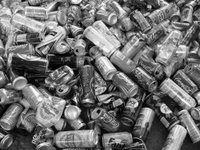
In a nutshell Grosvenor Waste. Islington Council and six other North London boroughs manage its waste disposal and recycling activities throgh the North London Waste Authority. In turn the NLWA has contracts with London Waste who handle non recyclable waste and composting and Grosvenor Waste who handle the contents of the green boxes.
The contents of the green boxes is mechanically sorted at the Materials Recyling Facility at Crayford by passing the waste through rotating drums etc. A lot but not all of the recyclable material can be easily extracted. The residual waste has to be landfilled or incinerated. However in some high profile news stories covered by the BBC and the Guardian, some of this waste has turned up in Indonesia and China.
Of course it would be much better to get householders to sort all waste into separate bins and collect separately. And this used to happen in Islington up to a couple of years ago. Contamination of the recycled materials such as the glass is much lower and the glass fetches a better price. The problem is that Inner London boroughs like Islington and Hackney have previously struggled to get their recycling rates up to the same level as the middle class boroughs like Barnet and the argument is that it is better to have an easier system that encourages higher participation. Their is another reason; the UK government is obliged to reach recycling levels determined by the EU. Unfortunately the emphasis is on the weight of waste collected rather than the energy recovered or the quality of the recycled material.
From our point of as residents, the best tip is to avoid packaging materials and when you have to buy packaged items, select items that are wrapped with packaging that Grosvenor Waste can handle. Cardboard, card and paper and good; most plastics are bad because they cannot be distinguished from one another. Compound materials like plastic welded onto cardboard, used in tetrapaks cannot be recycled by Grosvenor Waste; there are alternatives.
Islington Council provides a limited amount of information about their green box scheme. We have asked the Council to set up an email list so that residents can keep in touch with developments about their recycling service. However they do not think this would be worthwhile as many residents do not have internet access would be excluded.
Things do change and do email me if you think any of this is now out of date or wrong.
P.S. The NLWA has set up the North London Recycling Forum which is a network of council officers, and organisations and small businesses offering recycling solutions.





I asked Hackney Council where their green box recyclables go, by way of comparison. They do seem to go to a range of sensible places. Why don't all councils at least do this, since it seems to be possible.
ReplyDeleteThe hand sorted separation process used by Hackney Council for the Green Box scheme means that the recyclable materials are a very high quality for reprocessing.
What happens to recyclable materials?
• Batteries are taken to G&P Batteries, based in Darleston, who specialise in recycling and processing both lead and non-lead acid batteries.
• Foil goes to the Forest Recycling Project, a not for profit recycling organisation, who sort it and send it on to be recycled. The money raised is used in tree planting
programs.
• Garden waste is sent to London Waste Ltd in Enfield, then, together with other North London boroughs, it is sent to Essex to be turned into compost for Hackney’s parks and green spaces.
• Kitchen waste is sent to Edmonton where it is also turned into compost and used to nurture Hackney parks and green spaces.
• Plastic bottles are collected from the recycling banks and sent to a facility in Greenwich operated by Cleanaway Ltd.
• Textiles are collected by our usual contractor (ECT) if left in the Green Box, or by Oxfam or TRAID (registered charities) if left in one of Hackney’s textile banks. In each case, the materials will be sorted into two streams: one for reusable clothes for charity, and the other to be reprocessed to make felt, wadding and dusters.
• Tins and cans are sent to a company called AMG in Wales, where they are turned straight back into more tins and cans.
• Glass is separated into colours and sent to a special plant in Harlow which is run by British Glass. After it has been thoroughly cleaned to remove things like labels and plastic, it is mixed with other materials and melted down to be turned back into more bottles and jars. The glass produced is of the same quality as non-recycled glass. Glass can
be recycled again and again without losing its clarity or purity.
• Paper is taken to Ayleford Newsprint in Kent, where it is turned into paper for newspapers across Europe.
• Yellow Pages are a very low grade paper so cannot be treated like normal paper. It is sent to Raven’s Waste Paper in Croydon, who shred it for animal bedding.
• Card is often of lower quality than paper. Card can't generally be turned into paper, and is usually turned into more card.
• Oil is dealt with by a company called Malary Environmental Services, who recover the pure oil and clean the water that is left over.
Emma Sutton
Waste & Recycling Awareness Manager
Neighbourhoods & Regeneration
2nd Floor, Dorothy Hodgkins House
12 Reading Lane, E8 1HJ
Tel: 0208 356 2076
Fax: 0208 356 3507
www.hackney.gov.uk/recycling
Posted on behalf of Judy